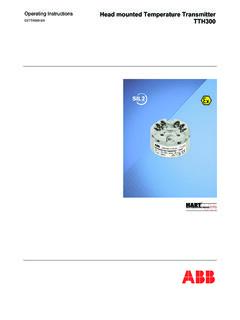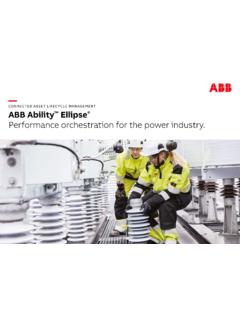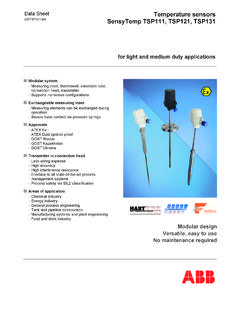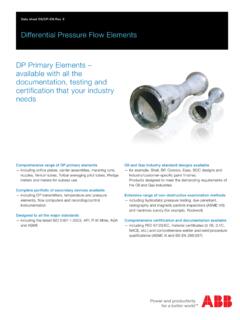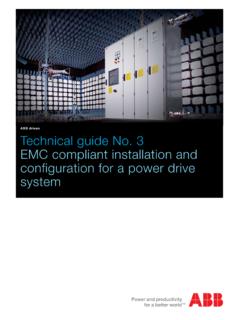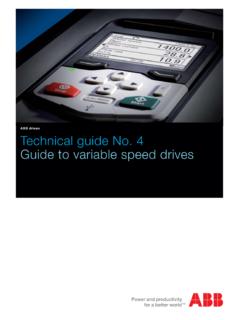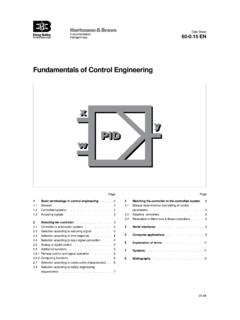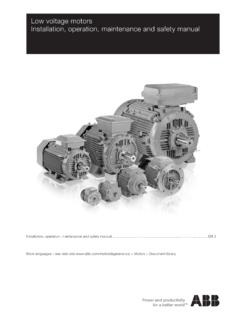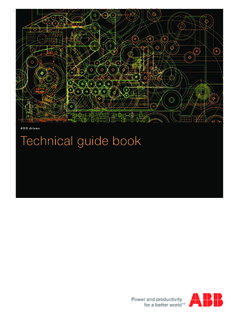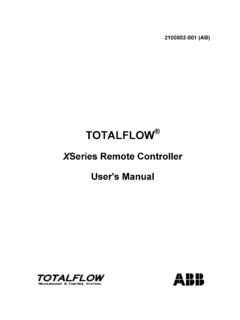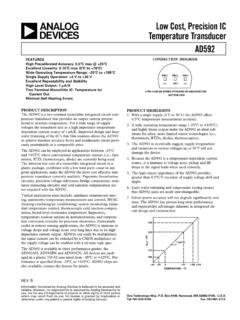Transcription of Type CO Overcurrent Relay Instruction Leaflet - ABB
1 41-101 UType CO Overcurrent Relay2 Figure 1: Type CO Relay Without Case. 1 = Indicating Instantaneous Trip (IIT). 2 = IIT Adjusting Screw. 3 = Indicating Contactor Switch (ICS). 4 = Indicating Contactor Switch Tap 2: Time Overcurrent Unit (Front View). 1 = Tap block. 2 = Time Dial. 3 = Control Spring Assembly. 4 = Disc. 5= Stationary Contact Assembly. 6 = Magnetic Plugs. 7 = Permanent CO Overcurrent Relay41-101U3 Figure 3: E Type Electromagnet. 1= Magnet Plugs. 2= Tap Block. 3= Tap 4: Indicating Instantaneous Trip Unit (IIT).Figure 5: Indicating Contactor Switch (ICS).41-101 UType CO Overcurrent CONSTRUCTION AND OPERATIONThe type CO relays consist of an Overcurrent unit(CO), an indicating contactor switch (ICS), and an in-dicating instantaneous trip unit (IIT) when principal component parts of the Relay and theirlocation are shown in Figures 1 through 5.
2 Electromagnets for the types CO-5, CO-6, CO-7, CO-8 and CO-9 relays have a main tappedcoil located on the center leg of an E type laminat-ed structure that produces a flux which divides andreturns through the outer legs. A shading coil causesthe flux through the left leg to lag the main pole out-of-phase fluxes thus produced in the air gapcause a contact closing torque. A torque controlledCO has the lag coil connections of the electromagnetbrought out to separate terminals. This permits con-trol of the closing torque such that only when theseterminals are connected together will the unit electromagnets for the types CO-2 and CO-11relays have a main coil consisting of a tapped prima-ry winding and a fixed secondary winding.
3 Identicalcoils are on the outer legs of the lamination structureand are connected to the main coil fixed secondaryin a manner so that the combination of all the fluxesproduced by the electromagnet result in out-of-phase fluxes in the air gap. The out-of-phase air gapfluxes produced cause a contact closing CONTACTOR SWITCH UNIT (ICS)The dc indicating contactor switch is a small clappertype device. A magnetic armature, to which leaf-spring mounted contacts are attached, is attracted tothe magnetic core upon energization of the the switch closes the moving contacts bridgetwo stationary contacts, completing the trip during this operation two fingers on the arma-ture deflect a spring located on the front of theswitch, which allows the operation indicator target front spring, in addition to holding the target,provides restraint for the armature and thus controlsthe pickup value of the INSTANTANEOUS TRIP UNIT (IIT)The instantaneous trip unit is a small ac operatedclapper type device.
4 A magnetic armature, to whichleaf-spring mounted contacts are attached, is at-tracted to the magnetic core upon energization of theswitch. When the switch closes, the moving contactsbridge two stationary contacts completing the trip cir-cuit. Also, during the operation, two fingers on the ar-mature deflect a spring located on the front of theswitch which allows the operation indictor target 6: External Schematic of the circuit -Closing Type CO Relay for Phase and Ground OvercurrentProtection on a Three-Phase 3182A755 Type CO Overcurrent Relay41-101U5 ENERGY REQUIREMENTSTYPE CO-2 RELAYVOLT AMPERES**ContinuousOne SecondPowerAtAt 3 TimesAt 10 TimesAt 20 TimesAmpereRatingRating*FactorTap ValueTap ValueTap ValueTap ValueRangeTap(Amperes)(Amperes)Angle AMPERES**ContinuousOne SecondPowerAtAt 3 TimesAt 10 TimesAt 20 TimesAmpereRatingRating*FactorTap ValueTap ValueTap ValueTap ValueRangeTap(Amperes)(Amperes)Angle *Thermal capacities for short times other than one second may be calculated on the basis of time being inversely proportional to the square of the current.
5 Degrees current lags voltage at tap value current.**Voltages taken with Rectox type LONG TIME AND CO-6 DEFINITE MINIMUM TIME RELAYS41-101 UType CO Overcurrent Relay6 ENERGY REQUIREMENTSCO-7 MODERATELY INVERSE TIME RELAYVOLT AMPERES**ContinuousOne SecondPowerAtAt 3 TimesAt 10 TimesAt 20 TimesAmpereRatingRating*FactorTap ValueTap ValueTap ValueTap ValueRangeTap(Amperes)(Amperes)Angle LONG TIME AND CO-9 DEFINITE MINIMUM TIME RELAYSVOLT AMPERES**ContinuousOne SecondPowerAtAt 3 Times At 10 Times At 20 TimesAmpereRatingRating*FactorTap Value Tap ValueTap ValueTap ValueRangeTap(Amperes)(Amperes)Angle *Thermal capacities for short times other than one second may be calculated on the basis of time being inversely proportional to the square of the current.
6 Degrees current lags voltage at tap value current.**Voltages taken with Rectox type CO Overcurrent Relay41-101U7 VOLT AMPERES**ContinuousOne SecondPowerAtAt 3 TimesAt 10 TimesAt 20 TimesAmpereRatingRating*FactorTap ValueTap ValueTap ValueTap ValueRangeTap(Amperes)(Amperes)Angle . *Thermal capacities for short times other than one second may be calculated on the basis of time being inversely proportional to the square of the current. Degrees current lags voltage at tap value current.**Voltages taken with Rectox type REQUIREMENTSTYPE CO-11 RELAYINSTANTANEOUS TRIP UNIT (IIT)RANGE INBURDEN IN VOLT-AMPS ATAMPERESMINIMUM SETTINGMAXIMUM SETTING2- - - - - CO Overcurrent Relay8 Figure 7: Typical Time Curves of the Type CO-2 RelaySub 1619584 Type CO Overcurrent Relay41-101U9 Figure 8: Typical Time Curves of the Type CO-5 RelaySub 241824541-101 UType CO Overcurrent Relay10 Figure 9: Typical Time Curves of the Type CO-6 RelaySub 2418246 Type CO Overcurrent Relay41-101U11*Sub 2418247 Figure 10: Typical Time Curves of the Type CO-7 Relay *Denotes Change 41-101 UType CO Overcurrent Relay12 Figure 11.
7 Typical Time Curves of the Type CO-8 RelaySub 2418248 Type CO Overcurrent Relay41-101U13 Figure 12: Typical Time Curves of the Type CO-9 241824941-101 UType CO Overcurrent Relay14 Figure 13: Typical Time Curves of the Type CO-11 2288B655 Type CO Overcurrent Relay41-101U15A core screw accessible from the top of the switchprovides the adjustable pickup CHARACTERISTICSThe relays are generally available in the followingcurrent relays may have either single or double circuitclosing contacts for tripping either one or two time vs. current characteristics are shown in Fig-ures 7 to 13. These characteristics give the contactclosing time for the various time dial settings whenthe indicted multiples of tap value current are appliedto the CIRCUITThe main contacts will close 30 amperes at 250 voltsdc and the seal-in contacts of the indicating contac-tor switch will carry this current long enough to trip acircuit indicating instantaneous trip contacts will close30 amperes at 250 volts dc, and will carry this cur-rent long enough to trip a indicating contactor switch has two taps thatprovide a pickup setting of to 2 amperes.
8 Tochange taps requires connecting the lead located infront of the tap block to the desired setting by meansof a screw circuit CONSTANTSC ontactor Switch ampere tap = ohms dc ampere tap = ohms dc SETTINGSCAUTION!Since the tap block screw on both the CO unitand IIT unit carries operating current, be surethat the screws are turned order to avoid opening current transformercircuits when changing taps under load, the re-lay must be first removed from the case. Chassisoperating shorting switches on the case will short thesecondary of the current transformer. The tapsshould then be changed with the Relay outside of thecase and then re-inserted into the.
9 1 - . - - - Available for Type CO-11 Relay 14: Internal Schematic of the Double Trip circuit Closing Relay . For the Single Trip Relay the Circuits Associated with Terminal 2 are Omit-ted. Figure 15: Internal Schematic of the Single Trip circuit -Closing Relay with Indicating Instantaneous Trip 357D4524 Sub 757D452541-101 UType CO Overcurrent UNITThe Overcurrent unit settings can be defined eitherby tap setting and time dial position or by tap settingand a specific time of operation at some multiple ofthe current tap setting ( , 4 tap setting, 2 time dialposition or 4 tap setting. seconds at 6 times tapvalue current).To provide selective circuit breaker operation, a min-imum coordinating time of seconds plus circuitbreaker time is recommended between the Relay be-ing set and the relays with which coordination is tobe screw on the terminal plate above the time dialmakes connections to various turns on the operatingcoil.
10 By placing this screw in the various terminalplate holes, the Relay will respond to multiples of tapvalue currents in accordance with the various typicaltime-current RECLOSINGThe factory adjustment of the CO unit contacts pro-vides a contact follow. Where circuit breaker reclos-ing will be initiated immediately after a trip by the COcontact, the time of the opening of the contactsshould be a minimum. This condition is obtained byloosening the stationary contact mounting screw, re-moving the contact plate and then replacing the platewith the bent end resting against the contact double trip relays, the upper stationary contact isadjusted such that the contact spring rests solidlyagainst the back stop.
